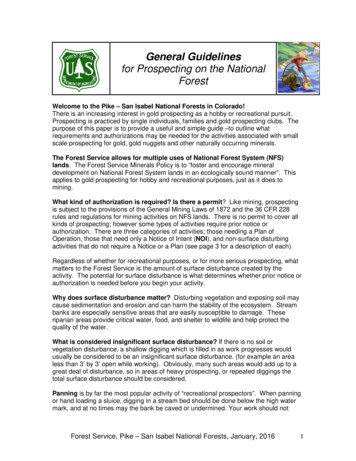
Transcription
General Guidelinesfor Prospecting on the NationalForestWelcome to the Pike – San Isabel National Forests in Colorado!There is an increasing interest in gold prospecting as a hobby or recreational pursuit.Prospecting is practiced by single individuals, families and gold prospecting clubs. Thepurpose of this paper is to provide a useful and simple guide –to outline whatrequirements and authorizations may be needed for the activities associated with smallscale prospecting for gold, gold nuggets and other naturally occurring minerals.The Forest Service allows for multiple uses of National Forest System (NFS)lands. The Forest Service Minerals Policy is to “foster and encourage mineraldevelopment on National Forest System lands in an ecologically sound manner”. Thisapplies to gold prospecting for hobby and recreational purposes, just as it does tomining.What kind of authorization is required? Is there a permit? Like mining, prospectingis subject to the provisions of the General Mining Laws of 1872 and the 36 CFR 228rules and regulations for mining activities on NFS lands. There is no permit to cover allkinds of prospecting; however some types of activities require prior notice orauthorization. There are three categories of activities; those needing a Plan ofOperation, those that need only a Notice of Intent (NOI), and non-surface disturbingactivities that do not require a Notice or a Plan (see page 3 for a description of each).Regardless of whether for recreational purposes, or for more serious prospecting, whatmatters to the Forest Service is the amount of surface disturbance created by theactivity. The potential for surface disturbance is what determines whether prior notice orauthorization is needed before you begin your activity.Why does surface disturbance matter? Disturbing vegetation and exposing soil maycause sedimentation and erosion and can harm the stability of the ecosystem. Streambanks are especially sensitive areas that are easily susceptible to damage. Theseriparian areas provide critical water, food, and shelter to wildlife and help protect thequality of the water.What is considered insignificant surface disturbance? If there is no soil orvegetation disturbance, a shallow digging which is filled in as work progresses wouldusually be considered to be an insignificant surface disturbance. (for example an arealess than 3’ by 3’ open while working). Obviously, many such areas would add up to agreat deal of disturbance, so in areas of heavy prospecting, or repeated diggings thetotal surface disturbance should be considered.Panning is by far the most popular activity of “recreational prospectors”. When panningor hand loading a sluice, digging in a stream bed should be done below the high watermark, and at no times may the bank be caved or undermined. Your work should notForest Service, Pike – San Isabel National Forests, January, 20161
undercut riparian vegetation or expose tree roots. Please removeall litter and refrain from digging above the high water mark.Return any sand and gravel to the hole from which it was removed.You do not need a permit or other authorization from the Forest Service for smallscale panning or prospecting with a pick and shovel. If you have something largerscale in mind or use any type of mechanized equipment you will need to work with theDistrict Ranger for approval of the activity and plans for reclamation of the site.Mechanized equipment can disturb a much greater area and process more material in arelatively short time. With mechanized equipment of any type, there is more potential fordisturbing important or sensitive species during key seasons, for example in nesting,mating or spawning seasons.High Banking is directing a hose or stream of water to wash away a portion of a bankwhile directing the runoff through a sluice. High banking is not allowed on the NationalForest.Dry Washers are another popular tool for the more serious hobbyist. Hand-crank,battery and small engine dry washers use vibration and blown air to separate heavymetals from dry sediments. The sand and gravel should be returned to the same holefrom which it was excavated. The amount of surface disturbance is considered indetermining whether prior notification or authorization may be needed.Suction Dredges can also be used for small scale operations but the local RangerDistrict should be contacted before beginning your operation. That allows a review ofyour plans to determine if, for example, any species might be affected by the timing ofyour work. Permits from the State and/or the Corp of Engineers may be required toinsure compliance with the Clean Water Act. Suction dredges or any other motor drivenequipment are prohibited in all of the designated Wildernesses.Metal Detectors are allowed for prospecting, without permits unless it is for a commercialventure. However, metal detectors are prohibited for use in historical archeological sites.Any site that contains remnants of man’s activity that is over fifty years old, or even newer ifit has unique historical significance, is protected by law. Many old mining camps and millsare located in the same kind of areas that you are interested in exploring for valuablemineral deposits. With every type of surface disturbing activity, there is potential fordisturbing archeological resources. It is your responsibility to insure that you are not withinany archeological site. Should artifacts be encountered, you should leave all articles inplace.Treasure Hunting (Treasure Troves) does require a special use permit from the ForestService. If you want to search for buried or lost treasures you will need to contact the localDistrict Ranger.Abandoned Mines are dangerous places that are likely to shelter snakes and other wildanimals, have rotted timbers, poisonous gases, radon buildup, deep shafts, undetonatedexplosives, and numerous other life threatening hazards. Do not enter any abandonedmine.Forest Service, Pike – San Isabel National Forests, January, 20162
General Guidelinesfor Filing and Processing ProposedLocatable Mineral OperationsForest Service regulations establish 3 categories of locatable mineral operations,based on the potential disturbance to National Forest resources: Notice of Intent (NOI) or a Plan of Operations (POO) is not required, NOI is required POO is requiredCategory I: No NOI or POO Required Examples:1. Where vehicles stay on existing roads open to the public,2. Search for and occasional removal of small mineral samples or specimens, and3. Staking of a mining claim.4. In general, where the disturbance is the same as from other Forest users where nopermit or approval is required.Category II: Notice of Intent Required Purpose of an NOI is to give a District Ranger enough information to tell if the level ofdisturbance will require a POO and a detailed environmental analysis. District Ranger will within 15 days of NOI receipt, evaluate it and notify operator if aPOO is required. If uncertain, operator should file an NOI. NOI can simply be a letter to the District Ranger Contents of NOI:1. Name, address, and telephone number of the operator. The NOI should besigned and dated by the operator.2. Area involved. Include township, range, and ¼ section of where proposal will occurand how to find the area on the ground. Enclose a detailed map or sketch with the NOIshowing operations location & scale.3. Nature of proposed operations. Describe (a) what you plan to do, & (b) whenand how you will be operating, (c) the proposed start-up date, and (d) theexpected duration of the activities. The District Ranger may contact you regardingthe following information: the number of people involved in the operation, equipment youintend to use (sizes, capacity, and frequency of use),area and depth of proposed excavation, how waste material will be handled, whatvegetation will be removed, size of total area to be disturbed, quantity of material to beremoved, and whether storage or camping facilities are to be used.4. Access route to the area of operations.5. Method of transport. Describe the vehicles or other transport used to carry people,equipment, supplies, and living quarters.Forest Service, Pike – San Isabel National Forests, January, 20163
Category III: Plan of Operations Required If the District Ranger determines that the proposed mineral operation will likely causea significant surface disturbance, a Plan of Operations (POO) is required. Information required for a POO is more extensive than for an NOI. Some examples of activities that require a POO:1. use of mechanized earth moving equipment (backhoe, dozer, dredge),2. constructing, placing, or maintaining roads, trails, structures, fences, orother improvements,3. occupancy or use of structures,4. cutting trees,5. digging of pits, trenches, or adits,6. storage or discharge of hazardous materials or mine waste,7. activities that might affect water quality or quantity, and8. activities that might affect species protected under Endangered Species Act. Contents of Plan of Operations:1. Name & address of operator/claimant2. Map of the proposed operating areaDescribe location, size of disturbed area, dates of operation, trenches, pits,ponds, streams, dumps, drill pads, timber disposal, etc.3. Access (road & trail routes & needs), describe maintenance and/orreconstruction,specifications w/widths, grades, culverts, type of vehicle use, etc.4. Project descriptionWhat is the proposed mining, milling, exploration method?Describe materials, equipment, and workforce. What is the schedule for constructionand/or when are operations proposed to start up?Describe power requirements, what vegetation clearing will be necessary.Describe how you will stockpile topsoil removed for reclamation.Identify waste rock/tailings placement & disposal, the design of liners, and anyengineered facilities, as well as structures, tanks, pipelines, power, sewage, etc.5. Environmental protection measures. The POO must detail what measures will betaken to protect: Air quality (dust abatement, emissions), Water quality (storm water,discharges, etc.) and how diversions, storage, and treatment of materials will bedesigned. Monitoring Seasonal closures, interim reclamation Solid wastes Scenic values Fish & wildlife Cultural Resources Hazardous substances Reclamation POO Processing: Authorized Officer (usually the District Ranger) must promptly acknowledgereceipt of a POO, and Within 30 days, evaluate it and notify the operator of one of the following:1. POO has been approved,Forest Service, Pike – San Isabel National Forests, January, 20164
2. No POO is needed3. Operator needs to provide additional information and/or make changesin the POO4. FS needs more time to complete the POO review (up to 60 days exceptwhen the area is inaccessible or other legal constraints involved(ESA))5. FS must prepare an Environmental Impact Statement. District Ranger will determine when all the information necessary to evaluate thePOO has been received. District Ranger will also determine if a reclamation bond is required, and what theamount should be. Any operator aggrieved by a Forest Service decision may file an appeal under 36Code of Federal Regulations 251 Subpart C. The information presented in this handout is in accordance with 36 Code ofFederal Regulations 228.A, Locatable Minerals.Forest Service, Pike – San Isabel National Forests, January, 20165
There is an increasing interest in gold prospecting as a hobby or recreational pursuit. Prospecting is practiced by single individuals, families and gold prospecting clubs. The purpose of this paper is to provide a useful and simple guide -to outline what requirements and authorizations may be needed for the activities associated with small










